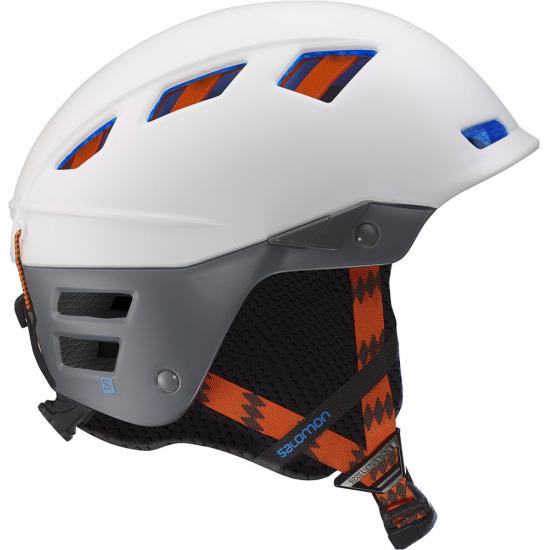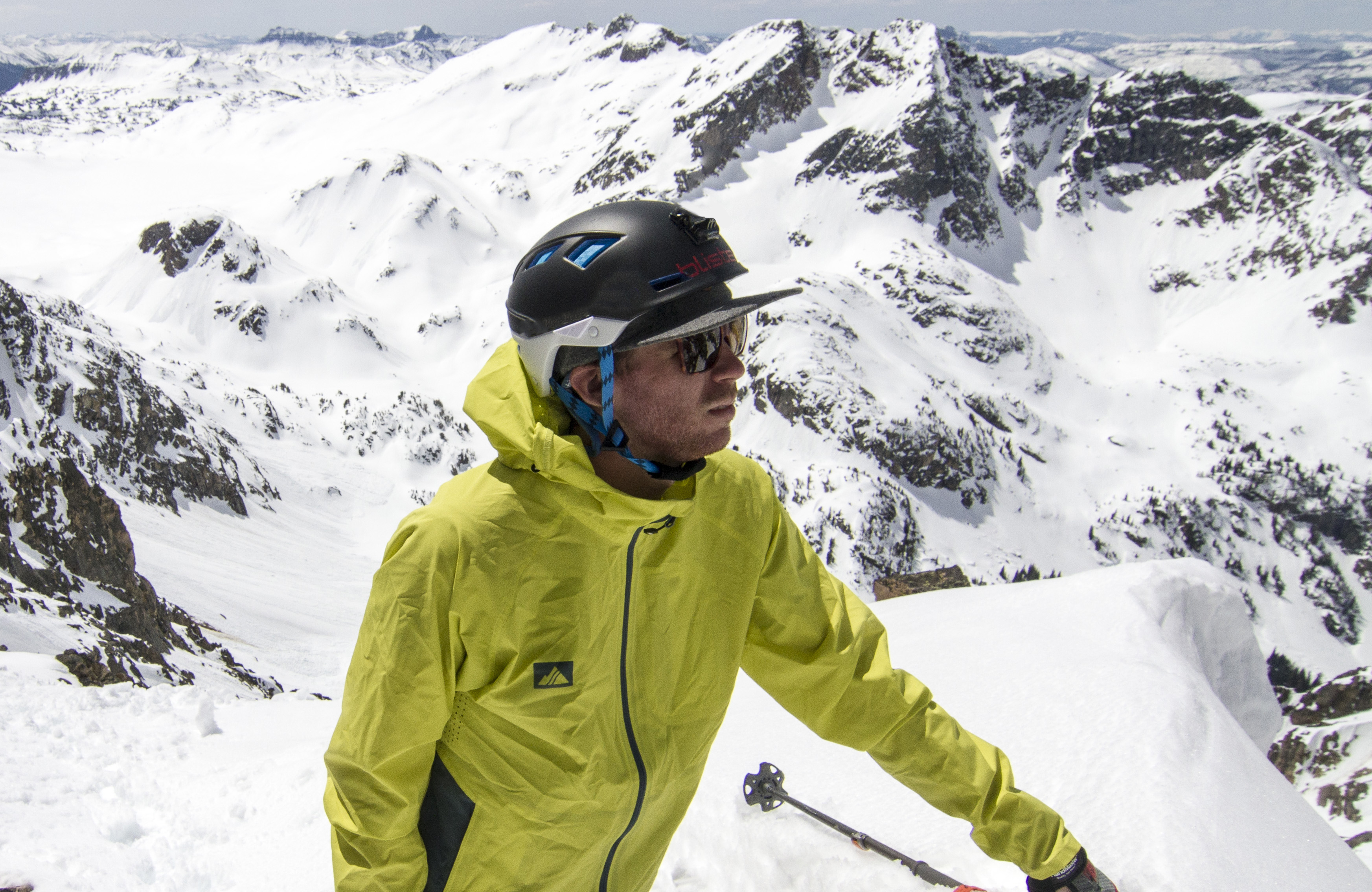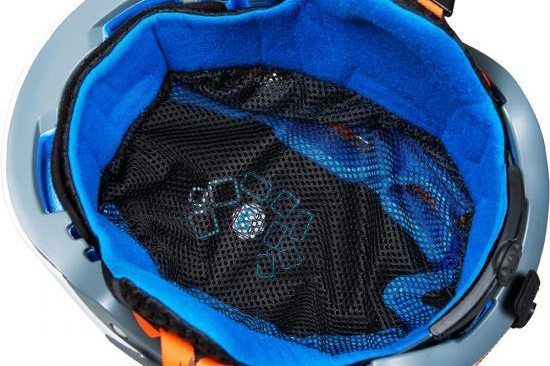
Salomon MTN Lab Helmet
Size Tested: Medium
Color: Black and White
Stated Features:
- Hybrid construction
- EPS 4D foam
- Merino wool blend lining
- Custom Dial Fit adjustment
- Active ventilation
- Includes BC backpack helmet bag
Stated Weight: 300 g
Blister’s Measured Weight:
- 379 g with liner
- 337 g without liner
MSRP: $200
Test Locations: Teton Pass & Grand Targhee Resort, WY; Mt Olympus, WA; Mt Hood & Mt Bachelor, OR.
Days Tested: 10
Intro
We’ve heaped a lot of praise on Salomon’s MTN Lab ski touring boot, but their is another product in the MTN Lab collection that is certainly worth discussing: the MTN Lab Helmet, which is specifically designed for skiers looking for lightweight protection while skiing and climbing…
Safety Ratings (and Why They Matter)
In many ski mountaineering situations, the nature of the objective danger changes throughout the course of the day. When climbing up steep couloirs—especially in the spring—it’s generally wise to wear a helmet to protect from any rock or debris falling from above. And when it’s time to ski down, it’s wise to wear a helmet for all the reasons your mom told you back when you started skiing.
But in the quest to shave weight and maximize comfort, many skiers instead use climbing helmets in mountaineering situations. Climbing helmets are typically lighter and more comfortable than traditional ski helmets, and offer great protection from falling debris on the climb. But when it’s time to ski, you pay for that lightweight comfort with decreased protection—especially on the back and the sides of the head.

While some people reach for a bike helmet to compromise between breathability and protection, I spent last spring skiing in a climbing helmet. I’d decided that comfort while climbing was more important to me than protection on the way down, so I huffed my way around the northwest in a Mammut El Cap. But I was acutely aware of the El Cap’s minimal side and back protection (plus the fact that I looked like a goober wearing ski goggles with it) so when the Salomon MTN Lab helmet came along, I was excited. Why?
Because the MTN Lab is rated as exceeding both CE-EN1077 / ASTM F-2040 (European and US Ski helmet standards) and CE-EN 12492 (the standard for mountaineering helmets). That CE-EN 12492 cert means the helmet has been tested, and rated for a range of direct impacts from above, as well as a few smaller impacts from the sides and back. CE-EN1077 / ASTM F-2040 covers a broader gamut of tests and impacts modeled after those commonly found while skiing.
Fit & Shape
With my 59 cm head, I fit perfectly in the size Medium MTN Lab helmet. I have room to adjust both bigger and smaller, and the overall fit is very similar to what I’d expect from a Medium helmet.
The MTN Lab has a bit more of an oval shape than a round one. I’d say it’s similar to the fit of most Giro helmets: just a little more long and skinny than round.
Helmet Liner (and why I tend to avoid ear flaps)
UPDATE: Salomon will be coming out with a summer liner for the MTN Lab this fall that doesn’t have ear flaps. We’ll update this review once we have time in the new liner.
The MTN Lab comes with a removable liner that features a mesh top and a lightly-padded headband with ear flap. It’s lighter than any other ski helmet liner I’ve used, and it breathes very well.
But before I’d actually used it, I was initially disappointed in the liner. I generally pull the liners out of all my helmets, because (1) I run very hot and need as much room to breathe as possible, and (2) I hate ear flaps—my ears don’t usually get cold, and they make it harder to hear, which is something that I already struggle with. So one of the things I loved about my climbing helmet was that there was no liner.

For the above reasons (and given the mountaineering nature of this helmet), I personally would have liked to see a more minimalist liner with just a sweatband and no earflaps. But having now toured in the liner, I’ve found that it breathes better than any other liner I’ve used.
However I was still frustrated by the ear flaps (blame my poor hearing), so I experimented with going liner-less. Without the liner, the MTN Lab is very uncomfortable, and it doesn’t feel safe. So I swapped in a five-panel baseball cap, and found that the MTN Lab fit very well with it.
Note: I’ve found five panels work better under a helmet since they don’t have the button on top, and there is less structure to the hat to interfere with the helmet.) I’ve also found that a five-panel hat breathes about as well as the stock liner, it keeps the helmet in place on my head, and it gives me a little extra brim while climbing. (For an even more breathable option I’ll probably swap in a mesh trail running cap later this spring.) Since a fair number of backcountry skiers are already rocking the hat-under-the-helmet look, the transition to the MTN Lab should be easy.
NEXT: Adjustment System, Venting, Etc.

For what it’s worth, I find the helmet reasonably comfortable without the liner. Certainly better with a hat or toque, but totally doable. The rest of this review totally reflects my opinion on the helmet, which I quite love for touring.
Are you sure that’s a MTN lab? Looks like a mtn patrol to me. And is the same weight as one. Labs come in white/grey and yellow, patrols in black
Any update on the new liner?
You said you don’t like ear flaps. This has removable ear flaps so I can’t believe you didn’t test the helmet with the liner and without the ear flaps for us. How could you not figure that out? If you can’t figure out how to remove the removable ear flaps you really shouldn’t be doing equipment reviews. Fail.
Hey James,
As I noted in the review, the earflaps are part of the liner, so they are removable — but only if you don’t mind taking the whole liner out. As I also noted in the review, I’ve been using the helmet without the liner or earflaps, and have just worn a hat underneath. It’s been very comfortable and I like the added brim.
Finally, as I mentioned, Salomon said they are coming out with a new summer liner without earflaps this year. Once that is available I’ll update the review with my impressions.
As I enter my second winter with this helmet it’s still my favorite option for long tours, big trips, and climbing exposed lines, although I am excited to try the new Dynafit ST helmet.
Thanks for the comment!
great review. just got the helmet and agree w/o liner its not so comfortable or secure (head wobble test), so curious to hear if you’ve compared to the Uvex p.8000, which appears quite similar in style but has a removable liner, separately removable ear pads, and without liner appears to still have some padding to make it more comfortable. also $50 cheaper, though slightly heavier (+50-60g).
Any idea what the difference is between the MTN lab and the MTN charge helmet? THnx
Anything new about the summer liner?
Have the same question as the two above :)
Hello,
Thank you for the great review.
I’m contemplating between getting a duel certified helmet like this one, or a dedicated ski helmet with MIPS technology for the extra protection. While weight and ventilation are factors to consider a tend to get cold and not to worry about an extra 100 gr. Are there any safety issues to consider when using a ski helmet for winter climbing? Are climbing certified helmets safer for falling rocks or ice?
Thank you,
Hello,
If you can, you should test ski helmets (skitouring helmets in particular) on safety and impact, because I bought a Salomon MTN Helmet, based on the positive reviews in terms of performance, weight, comfort, etc, but it got dented in the boot of my car lying between backpacks and skis. Salomon said it was no longer safe to use (reviewed the images I sent them). I bought it, used it for two days (brilliant helmet in terms of use), but have to throw it away now because of this. My old UVEX helmets have had crashes, hit by tree branches, etc, with only minor dents or scratches. Here it was so badly damaged that it was no longer safe to use. What would have happened if I had fallen at high speed or a if a rock had hit it….?
Did you guys only test a black one? Other reviews mention that the white helmet is a color magnet and will discolor/pick up colors from anything it rubs again. Is that true? I’d prefer white but not if it’s going to be a color sponge.
coming in late here – but OP wrote that his 59cm circumference head is a good fit for this helmet in M size. However, Salomon helmet sizing for M is 56 – 59cm. So he muts have been straddling the M and L sizes but yet he wrote that there was enough wiggle room to size down and up. Surely not up if the helmet’s size limit is 59cm according to the official literature. Thinking of the MTN helmet too, but I am between the sizes at 59cm also.